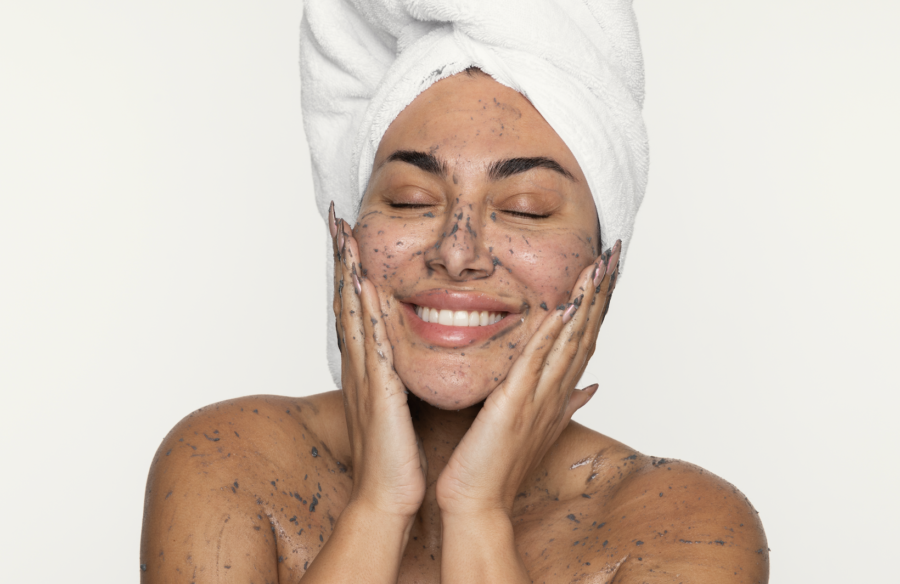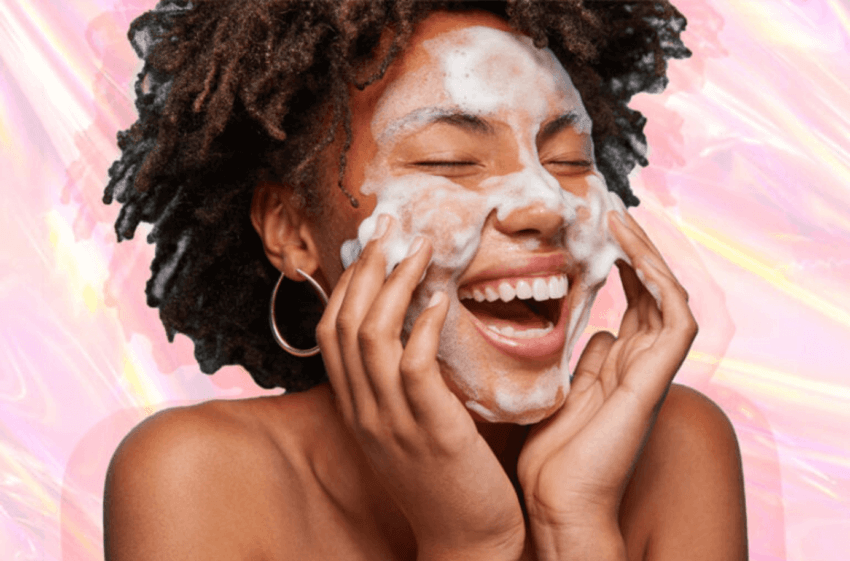Exfoliator 101: Acids, Enzymes & Scrubs (+ How TF To Use Them)

Exfoliating is one of the most integral steps in our skincare routine. With that said, it’s also a product that’s surrounded by a lot of confusion and misconceptions that could hinder rather than help your skin – yes, we’re referring to over-exfoliation but more on that later…
If your exfoliation journey started with a Neutrogena scrub as a teenager, we’re 100% with you. However, if you’ve moved on and are somewhat overwhelmed with different formulations and are wondering where to start, then don’t worry, because we’re breaking it all down for you. From physical to chemical exfoliators, each type comes with its own rule book, which dictates how to use it and how often. Lucky for you, we’ve outlined each form of exfoliation and how exactly it can help your skin.
Chemical Exfoliators

Chemical exfoliators have gained popularity over the past few years, praised for their glow-getting results and gentle formulations. While the term “chemical exfoliator” sounds scary, it’s an enzyme or acid-based formula that penetrates deep into your pores, dislodging and dissolving dead skin cells while simultaneously promoting skin regeneration. In short: it’s the bomb.com. There are multiple forms of chemical exfoliants from AHAs to BHAs, not to forget enzymes. Here’s a quick breakdown of each form of chemical exfoliant.
AHAs (Alpha Hydroxy Acids)
Suitable for: All skin types (depending on concentration and formulation)
AHAs like glycolic, lactic, or citric acid are water-soluble chemical exfoliators that gently dissolve the top layer of dead skin cells to reveal the smooth surface underneath. Usually fruit or plant-based, AHAs also stimulate skin renewal and regrowth, lessening pesky pigmentation, improving uneven tone, and increasing collagen production. Plus, thanks to their humectant properties, they also help to hydrate.
How to use: Start by incorporating AHA-based products into your routine once or twice a week. After your skin has adjusted to the pH change, you can up the frequency that you use them. But always check the label as overuse can leave skin red, burnt, and dry. And remember, every formula is different; we love those that combine AHAs with lots of hydrators and soothing ingredients. Glycolic tends to be the strongest while lactic is considered to be the most gentle, so the latter is a great place to start if you have more sensitive skin.
Our go-to AHA product? Pixie by Petra Glow Tonic, $15, which features glycolic acid combined with energizing ginseng and soothing aloe vera.
BHAs (Beta Hydroxy Acids)
Suitable for: Acne-prone, oily, and combination skin
BHAs are Queen B in the exfoliator category. BHAs are oil-soluble and they work by breaking down the bonds (or glue) that hold dead skin cells together, loosening dead skin cells so they’re easily sloughed away. BHAs, like salicylic acid or willow bark extract, are amazing for clarifying the skin and keeping breakouts at bay by cleansing deep into pores.
These hardworking acids also stimulate collagen production and improve wrinkles, texture, and hyperpigmentation. We’re obsessed with the Paula’s Choice Skin Perfecting 2% BHA Liquid Exfoliant, $30, which is formulated to unclog pores, smooth wrinkles, and even out skin tone. We also love The Inkey Lists Salicylic Acid Cleanser, $11, which is also formulated with sebum-controlling zinc, and allantoin to soothe and protect the skin.
Once again, introduce BHAs into your routine once or twice a week, and please don’t forget to slather on the sunscreen as BHAs will make your skin more sensitive to UV rays.
Enzymes
Suitable for: Dry to sensitive skin (or daily use for all skin types)
Exfoliating enzymes like papaya and bromelain offer a natural form of exfoliation by breaking down dead skin cells and keratin proteins so they can be gently removed. This helps to smooth the skin’s surface, reduce the appearance of dark spots, and brighten the skin for a glowier and more radiant complexion. Enzymes are gentler than AHAs, making them ideal for sensitive skin, or daily use.
Of course, we couldn’t explain enzyme exfoliation without mentioning our WISHFUL Yo Glow Enzyme Scrub, $39, which combines the powers of pineapple and papaya enzymes, as well as AHAs to buff away dead skin, leaving brighter and more radiant skin in its place. If you’re DIY obsessed like us, check out our fave DIY enzyme mask here.
Posts You'll Love:
Physical Exfoliators

Mechanical or physical exfoliators utilize small particles that buff away dead skin cells and dirt. Once again, there are multiple forms of physical exfoliators, some gentler than others. Here’s a quick breakdown:
Cellulose
Suitable for: All skin types, especially, dry, sensitive skin
Cellulose is a natural compound that clumps together as you rub the formula into your skin, gently removing dead skin that is ready to come off. It is possibly the most gentle type of physical exfoliator, and although it may look like you’re literally rubbing dead skin off your face, in reality, it is mostly the formula balling together. It also has moisturizing properties and is helpful in lots of different types of skincare formulas. We’re obsessed with cellulose scrubs, hence why it’s a key ingredient in our new WISHFUL Yo Detox Enzyme Scrub, $39, which offers a more intense exfoliation than our best-selling Yo Glow Enzyme Scrub, $39.
Granule Scrubs
Suitable for: Your body!
Scrubs that contain physical exfoliators like coffee, sugar or salt work by buffing away dead skin cells to reveal softer, more luminous skin underneath. However, when it comes to physical exfoliators like granular scrubs, you need to be very gentle as they can tear your skin or lead to over-exfoliation. We like to use natural physical scrubs on our bodies as the skin is thicker and less fragile. Check out our fave body scrubs here. Also, try to stay clear of plastic microbeads in facial scrubs as they contribute to the ever-growing plastic waste that’s harming aquatic wildlife and polluting our planet.
Material Exfoliators
Suitable for: All skin types
The final form of exfoliator is material exfoliators like microfiber towels, muslin cloths, or exfoliating body cloths. They offer a very gentle form of exfoliation as the texture of the material buffs away dead skin that’s sitting on the surface. We use our WISHFUL Microfibre Cleansing Cloth, $15, every day to remove our makeup with an oil-based cleanser as it leaves our skin feeling so soft and clean.
For more skincare advice, check out the skincare mistakes you could be making.






















Leave a comment